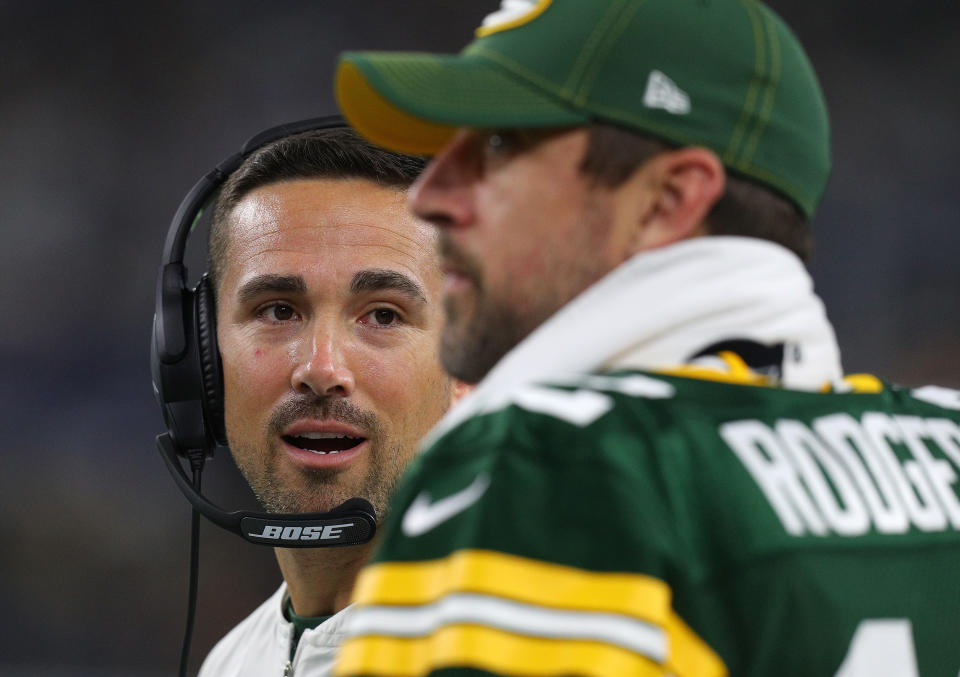Lessons learned: Aaron Rodgers, Le'Veon Bell, and other players to avoid in 2020 fantasy football leagues
One of the many benefits of assembling a best-ball roster in May is confirmation that your initial ranks are, in fact, trash.
[Create or join a 2020 Yahoo Fantasy Football League for free today]
If I had to give you one primary takeaway from the recently completed Yahoo staff best ball draft, it's that my ranks did not fully reflect my visceral disgust pessimistic fantasy outlook for several players.
Experts will sometimes tell you that best-ball drafting helps them learn the relative depth of various positions, or it assists in understanding the opportunity costs involved with selecting early QBs or tight ends. Personally, I find it's useful to see a few terrifying names sitting near the top of your queue — with seconds ticking off a draft clock — to truly appreciate your desire to not roster those players. Everything is purely theoretical until we start creating teams and paying league fees.
The only way to really know who's on your list of undraftables ... is to actually draft.
Here, in no particular order, are the guys who immediately received rankings downgrades as soon as we'd knocked out that first league ...
Le'Veon Bell, New York Jets
Bell was scandalously ineffective last season — historically so. He converted 311 touches into just four touchdowns. He averaged 3.2 YPC. Only five NFL backs since the merger have carried at least 240 times for less than 800 yards, and Bell is now one of 'em. Here's the full list:
Tom Sullivan, 1974 - 244 carries, 760 yards (3.1 YPC)
Rob Carpenter, 1984 - 250 carries, 795 yards (3.2 YPC)
Sammy Winder, 1986 - 240 carries, 789 yards (3.3 YPC)
Marion Butts, 1994 - 243 carries, 703 yards (2.9 YPC)
Le'Veon Bell, 2019 - 245 carries, 789 yards (3.2 YPC)
That is a very bad list, people. It's not a group any running back should want to be associated with. None of those first four guys ever had another quality season in the NFL. If Bell can somehow bounce back from last year's faceplant to deliver a productive season, he'll break new ground. And yet, he's typically selected inside the top-40 picks in NFFC leagues, which I cannot endorse (or even comprehend). Do not want.
Aaron Rodgers, Green Bay Packers
Ten years ago, back in 2011, Rodgers played his position at arguably the highest level anyone has ever achieved. He set the single-season record for passer-rating (122.5) and led the NFL in both TD percentage (9.0) and yards per attempt (9.2). He passed for 45 touchdowns and just six interceptions, averaging 309.5 yards per game. He was almost unimaginably great.
Last year, Rodgers was ... well, he was fine. Good, but nowhere near his peak. He remained at the fringes of QB1 territory for fantasy purposes, but only barely. He passed for 26 scores and only four picks but averaged just 7.0 yards per attempt and 250.1 per game. Rodgers is still only 36 years old — in an era in which the best quarterbacks still excel in their 40s — so we shouldn't expect him to nosedive in terms of skills or statistical output. But his receiving corps is now essentially only one guy, surrounded by a dreadful supporting cast. Green Bay's big offseason addition to the wide receiver depth was Devin Funchess. Woo. The team's draft did not directly benefit Rodgers in any obvious way.

Quarterback is an exceptionally deep position in typical fantasy formats, so it's a spot at which managers should always chase the highest ceilings. Rodgers, at this stage, is not a serious contender for a top-of-the-ranks positional finish. He's averaged just 259.6 yards and 1.7 TDs per game over the past three seasons. Not at all what I'm looking for.
Austin Hooper, Cleveland Browns
If Hooper would have simply remained in Atlanta, where he averaged a career-best 5.8 receptions and 60.5 yards per game last season, I would have been fully on board. He would have ranked no worse than sixth at his position on my cheat sheet. This season, more than any, is one in which year-to-year continuity is going to be a huge deal.
[2020 Draft Rankings: Overall | QBs | RBs | WRs | TEs | DST | Kickers]
Hooper did not stay in Atlanta, however, because Cleveland gave him a buncha million reasons to leave. Great for him in reality; bad news in terms of 2020 fantasy potential. He's joining an offense in which he has no existing rapport with his quarterback and facing, in all likelihood, an abbreviated camp and preseason. Also, the Browns fed 271 combined targets to OBJ and Jarvis Landry last year, plus another 93 to Kareem Hunt and Nick Chubb. It's not at all clear that Hooper has an easy path to another 70-catch season. If someone in your league is willing to draft him while expecting last year's totals, you gotta let him go.
Rob Gronkowski, Tampa Bay Buccaneers
Look, the NFL is clearly better and more entertaining with Gronk in it. No argument here. Post-sabbatical Gronk is probably going to be just fine. We're talking about an all-time great, and he's only 31. Chemistry with his quarterback is definitely not an issue.
My concerns begin with the fact that Gronkowski is a high-mileage 31 year old, having undergone nine surgeries (give or take) and suffered an unknowable number of concussions. He was a very good player when we last saw him in 2018, but nothing like vintage Gronk. He caught 47 balls for 682 yards over 13 games and averaged 52.5 yards per week, an eight-year low. Can he be more productive than that after a year away from the game? Um ... sure, maybe. Again, he's an all-time player. Those guys follow different rules. But I'm not about to actually draft him as if it's a given he'll be better or more explosive than he was in 2018. Someone in every league is going to be willing to pay a top-eight or top-ten price, however.
Devin Singletary, Buffalo Bills
Ahead of this year's draft, Singletary seemed like a rock-solid fantasy investment. He was excellent as a rookie in a limited role (5.1 YPC) and Frank Gore was out of the picture for 2020. But the Bills used a second-day pick on Utah's Zack Moss, a back with tackle-breaking ability and short-yardage size (220-plus pounds). Moss is clearly a threat to take most (if not all) of the 11.2 touches per game that went to Gore last season, including goal-to-go work. We should note that Gore handled 18 carries inside the 10-yard line for Buffalo last season while Josh Allen saw 11.
Singletary was left with only three.
If his role doesn't substantially change in his second year, Singletary’s a poor bet to earn his early ADP. That's gonna be a no from me.

